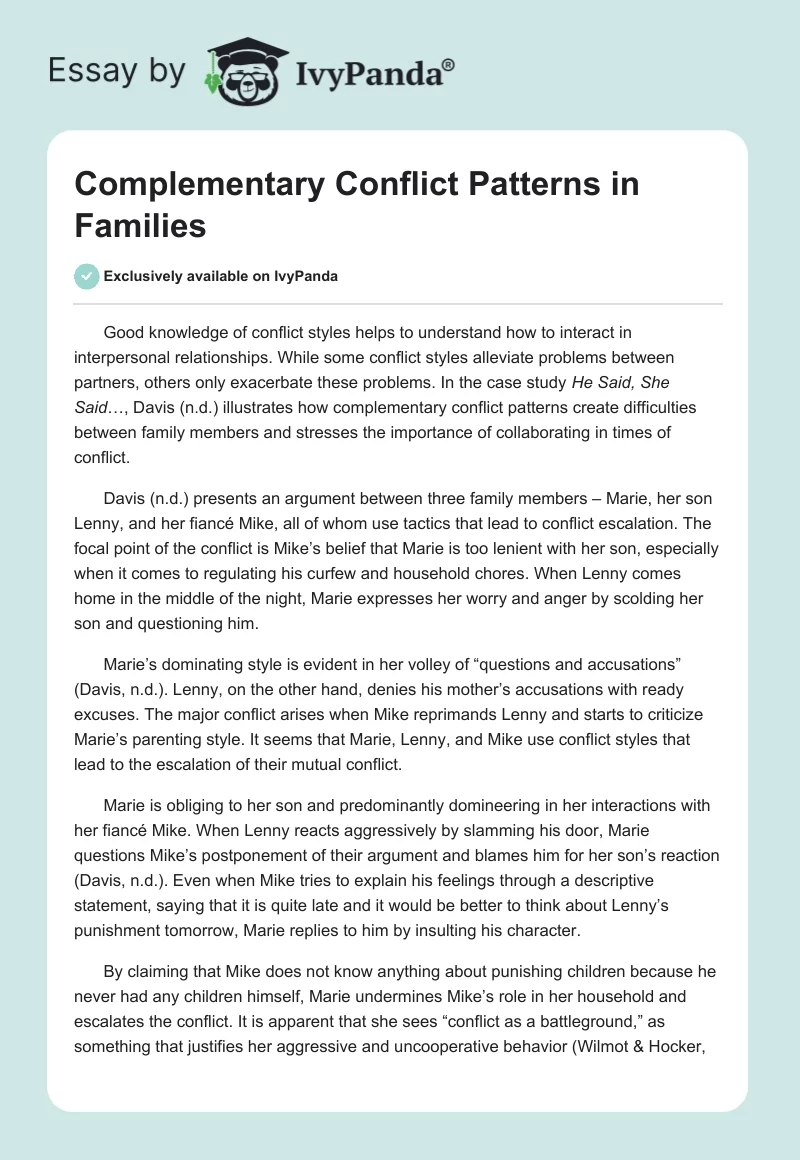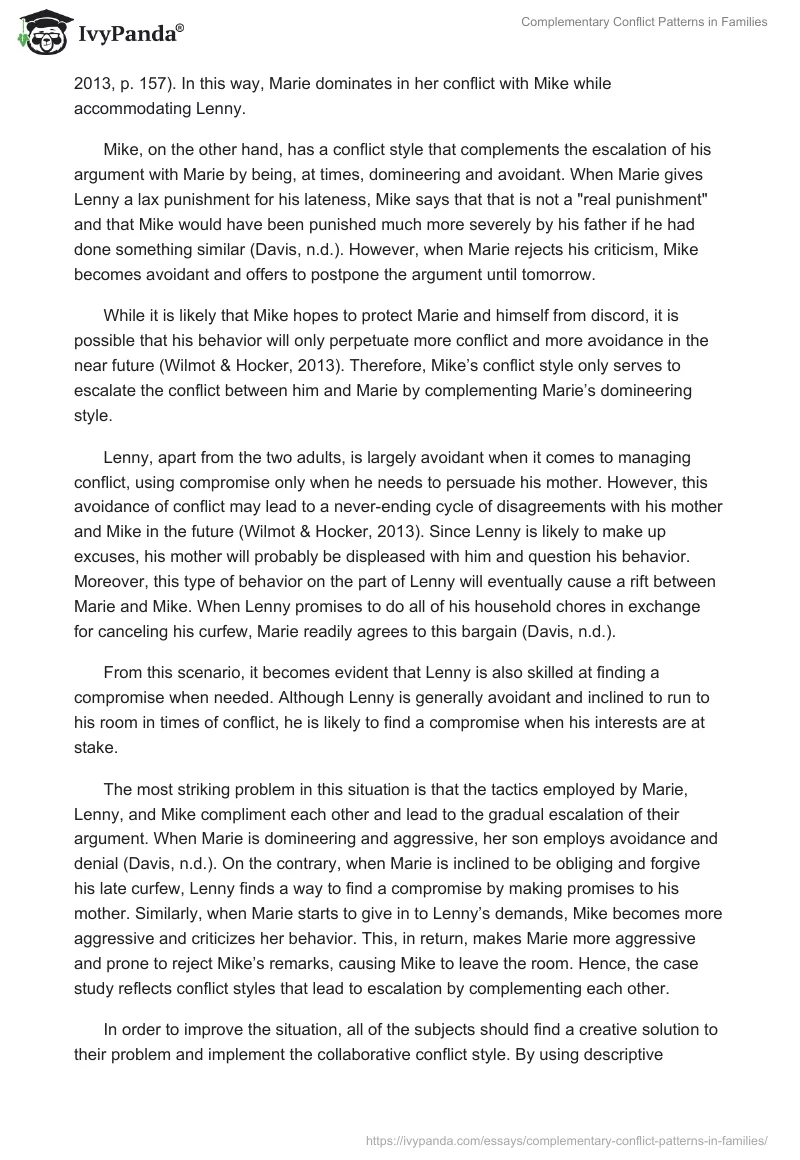Good knowledge of conflict styles helps to understand how to interact in interpersonal relationships. While some conflict styles alleviate problems between partners, others only exacerbate these problems. In the case study He Said, She Said…, Davis (n.d.) illustrates how complementary conflict patterns create difficulties between family members and stresses the importance of collaborating in times of conflict.
Davis (n.d.) presents an argument between three family members – Marie, her son Lenny, and her fiancé Mike, all of whom use tactics that lead to conflict escalation. The focal point of the conflict is Mike’s belief that Marie is too lenient with her son, especially when it comes to regulating his curfew and household chores. When Lenny comes home in the middle of the night, Marie expresses her worry and anger by scolding her son and questioning him.
Marie’s dominating style is evident in her volley of “questions and accusations” (Davis, n.d.). Lenny, on the other hand, denies his mother’s accusations with ready excuses. The major conflict arises when Mike reprimands Lenny and starts to criticize Marie’s parenting style. It seems that Marie, Lenny, and Mike use conflict styles that lead to the escalation of their mutual conflict.
Marie is obliging to her son and predominantly domineering in her interactions with her fiancé Mike. When Lenny reacts aggressively by slamming his door, Marie questions Mike’s postponement of their argument and blames him for her son’s reaction (Davis, n.d.). Even when Mike tries to explain his feelings through a descriptive statement, saying that it is quite late and it would be better to think about Lenny’s punishment tomorrow, Marie replies to him by insulting his character.
By claiming that Mike does not know anything about punishing children because he never had any children himself, Marie undermines Mike’s role in her household and escalates the conflict. It is apparent that she sees “conflict as a battleground,” as something that justifies her aggressive and uncooperative behavior (Wilmot & Hocker, 2013, p. 157). In this way, Marie dominates in her conflict with Mike while accommodating Lenny.
Mike, on the other hand, has a conflict style that complements the escalation of his argument with Marie by being, at times, domineering and avoidant. When Marie gives Lenny a lax punishment for his lateness, Mike says that that is not a “real punishment” and that Mike would have been punished much more severely by his father if he had done something similar (Davis, n.d.). However, when Marie rejects his criticism, Mike becomes avoidant and offers to postpone the argument until tomorrow.
While it is likely that Mike hopes to protect Marie and himself from discord, it is possible that his behavior will only perpetuate more conflict and more avoidance in the near future (Wilmot & Hocker, 2013). Therefore, Mike’s conflict style only serves to escalate the conflict between him and Marie by complementing Marie’s domineering style.
Lenny, apart from the two adults, is largely avoidant when it comes to managing conflict, using compromise only when he needs to persuade his mother. However, this avoidance of conflict may lead to a never-ending cycle of disagreements with his mother and Mike in the future (Wilmot & Hocker, 2013). Since Lenny is likely to make up excuses, his mother will probably be displeased with him and question his behavior. Moreover, this type of behavior on the part of Lenny will eventually cause a rift between Marie and Mike. When Lenny promises to do all of his household chores in exchange for canceling his curfew, Marie readily agrees to this bargain (Davis, n.d.).
From this scenario, it becomes evident that Lenny is also skilled at finding a compromise when needed. Although Lenny is generally avoidant and inclined to run to his room in times of conflict, he is likely to find a compromise when his interests are at stake.
The most striking problem in this situation is that the tactics employed by Marie, Lenny, and Mike compliment each other and lead to the gradual escalation of their argument. When Marie is domineering and aggressive, her son employs avoidance and denial (Davis, n.d.). On the contrary, when Marie is inclined to be obliging and forgive his late curfew, Lenny finds a way to find a compromise by making promises to his mother. Similarly, when Marie starts to give in to Lenny’s demands, Mike becomes more aggressive and criticizes her behavior. This, in return, makes Marie more aggressive and prone to reject Mike’s remarks, causing Mike to leave the room. Hence, the case study reflects conflict styles that lead to escalation by complementing each other.
In order to improve the situation, all of the subjects should find a creative solution to their problem and implement the collaborative conflict style. By using descriptive statements, making appropriate concessions, and accepting responsibility for the conflict, it would be possible to mitigate this argument between Marie, Mike, and Lenny (Wilmot & Hocker, 2013). Moreover, it is likely to improve their relationship overall. In general, the collaborative style would help to strengthen the bond between these three subjects and ease the tension between them.
All in all, the subjects in the study have conflict styles that complement one another and help to escalate their disagreement. By making concessions and accepting responsibility for their behavior, Marie, Mike, and Lenny would mitigate and solve their disagreement with greater ease. Therefore, the case study He Says, She Says… illustrates how three subjects need to change their conflict styles.
References
Davis, D. (n.d.). He said, she said… Web.
Wilmot, W., & Hocker, J. (2013). Interpersonal conflict (9th ed.). New York, NY: McGraw-Hill Education.


